One of the things you don't get from the high school history class version of the Civil War is the political division within the states. When most people think of a Civil War map it's usually a two-color map with the slave states and free states. But in reality, just like almost every civil war in history, it's not that simple. Especially on the border states, different factions quite literally fought it out to determine if the state would side with the Union or Confederacy.
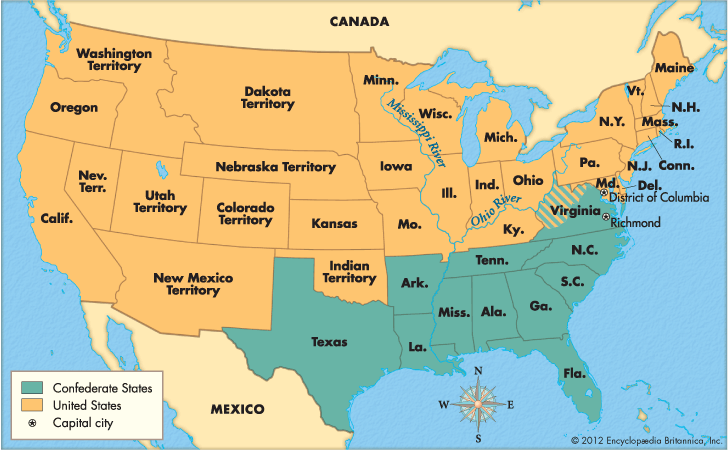
These border areas saw widespread guerilla warfare and neighbor-against-neighbor raids throughout that war that were a lot nastier and more complicated than a clean, two-color straight line on a state border might suggest. In Maryland President Abraham Lincoln suspended the constitutional right of habeas corpus and ordered the arrest of Southern sympathizers to keep the state in the Union. He ignored the ruling of Supreme Court Chief Justice Roger B. Taney's decision in 1861 concerning freeing John Merryman, a prominent Southern sympathizer arrested by the military. The split was so bad in western Virginia that the state split in the middle of the war forming what is today West Virginia. Slave state Missouri sent armies, generals, and supplies to both sides, maintained dual state governments, and endured a bloody neighbor-against-neighbor intrastate war within the larger national war. Even parts of the free states, such as southern Illinois, clearly preferred to be in the South and were essentially occupied territories by Union soldiers for large parts of the war. But of particular interest to us today, is Kentucky, which was another of the border states and officially declared its neutrality at the beginning of the war- a decision that neither Union nor Confederacy had any long term plans to respect. This was not the type of war you could neutrally sit out of.

Another of these border states not eager to get drawn into war was Tennessee. The electorate of Tennessee initially voted against succession in February 1861. After active war broke out and Lincoln issued his famous call for 75,000 volunteers (the Union Army would eventually enlist more than 2.6 million soldiers) the pro-succession governor of Tennessee refused to send troops to support the federal government and began conspiring with generals from already-succeeded Confederate states to fortify Tennessee's rivers against Union ships as if the state had already succeeded.

When preparing his state's defenses against Union advance, Tennessee governor may have been overconfident in the continued neutrality of Kentucky in this conflict because he focused the majority of the still-officially-neutral state's defensive works on the Mississippi River that forms the western border of Tennessee, instead of the on Tennessee River which slices north-south through state twice and the Cumberland River which traces a wide arc through the whole of northern Tennessee. That isn't to say that there was nothing done on these rivers...
In May 1861, just a month after the Confederate attack on Fort Sumter, Brigadier General Donelson led a surveying team along the Cumberland and Tennessee rivers and selected dual sites to build supporting forts, one on the eastern bank of the Tennessee River, the other other on the western bank of the Cumberland River at the point where the two rivers are separated by just a few miles in northwest Tennessee.
With military preparations underway and the pro-Confederate Governor of Tennessee marshaling troops and coordinating with Confederate generals and government forces while still officially neutral, another referendum was held in Tennessee on June 8, 1861, and amid widespread voter intimidation and outright fraud, the vote magically swung significantly towards succession, and shortly afterwards Tennessee became the 13th and last state government to officially succeed from the Union.
Just to the north of Tennessee, the pro-Union governor of Illinois was not taking any chances either. While Illinois as a whole was strongly pro-Union, southern Illinois was very much of divided loyalty. Just three days after the attack on Fort Sumter, the Illinois governor marshaled the state militia and secured pro-secessionist Cairo at the mouth of the Mississippi River and at the very southern tip of Illinois. It would be another three months before Grant the regular Union arrived to take control of the city, established a base of operation, and stopped all river traffic flowing south. This was the very first step in General Winfield Scott's Anaconda Plan.
By the end of that first August, the fleet assembled at Cairo consisted of three timberclads, nine ironclads, and 38 more mortar boats on order designed for pummeling Confederate forts into submission. In September, Captain Andrew H. Foote, soon to be promoted to Rear Admiral Foote, arrived to take command of the newly christened Western Flotilla at the same time that Brigadier General Grant, the new Army commander of the District of Southeast Missouri arrived there. The two officers, and the services they represented (this was an era of intense interservice rivalries) had a bit of a rocky start given the limited pool of resources to support both the Army and the Navy, but the two commanders respected each other as professionals and both were unusually open to joint operations compared to some of their more hidebound peers.
Here I'm going to summarize and a bit from the Naval History and Heritage Command account of the prelude to the battle:
Within a week of their introduction, Grant and Foote engaged in their first joint operation: the seizure of Paducah [a major transportation hub of rail and port facilities at the mouth of the Tennessee River] in the neutral state of Kentucky.
If you remember, Kentucky was one of the border states in the war, and the official position of the Kentucky government was to stay out of the conflict, but as I said before, this was an impossible ask. Within months of the shots at Fort Sumter, Kentucky's neutrality was first violated on September 3, when Confederate Brigadier General Pillow occupied Columbus, Kentucky, which overlooked strong defensive bluffs, to defend the Mississippi from Union offensive action and was the terminus of the Memphis & Ohio railroad, which in turn leads southwards to the extremely important Charleston & Memphis railroad. Immediately across the river from Columbus in Belmont, General Polk stationed his troops which prompted the Battle of Belmont that we talked about in the first episode. Now that the pretense of neutrality was broken, Lincoln was not going to give up Kentucky. He thought it was so vital and a harbinger of what the other border states would do, that he wrote in a letter from Washington DC that, "I think to lose Kentucky is nearly the same as to lose the whole game. Kentucky gone, we cannot hold Missouri, nor, as I think, Maryland. These all against us, the job on our hands is too large for us. We would as well consent to separation at once, including the surrender of this capital."
The victory at Paducah was what the pro-Union state legislature needed to override the pro-Confederate Kentucky Governor's veto, and the next day the elected government of Kentucky declared itself for the Union, which immediately prompted a separate pro-Confederate government to form and decamp for the southern part of the state held by the Confederate Army. The official battle line between North and South was now set in the west, a line in the southern regions of Kentucky and the northern regions of Tennessee, stretching from Columbus in the west to Cumberland Gap in the east. And so, Grant and Foote moved down the Cumberland River to take the battle to the enemy.
The capture of Paducah solidified a line of advance down the Cumberland River and provided an excellent vantage point for the Western Flotilla to observe the enemy fortifications and prepare to break through their line of defense at its center.
...[Confederate] Brigadier General Lloyd Tilghman was sent to take command of both Fort Henry and Donelson. As an engineer, Tilghman immediately understood the vulnerability of Fort Henry. He assigned a contingent to build a new fort on the high bluffs of the opposite bank, which had previously been unacceptable because of the neutrality of Kentucky. Construction began in December, but it was not yet equipped in February 1862 when the U.S. forces mobilized for movement down the Tennessee River. Tilghman knew their weak point, but they had no time to correct the mistake before the spring floods brought the U.S. forces up the river from Paducah.
[Meanwhile, Union] Brigadier General Charles F. Smith began gathering intelligence as soon as he received command at Paducah in September. He accompanied river patrols upstream to determine the strength of the forts on the two rivers... The high water of the spring months was ideal for this campaign as the Tennessee and Cumberland rivers could only be navigated by small steamers throughout most of the year [and not big ironclads]...
...On 2 February, Foote’s expedition departed from Cairo. The Union fleet numbered seven gunboats, four ironclads and three timberclads. The army transports followed, carrying most of [Grant's] 15,000 soldiers... Grant and his forces planned to move overland from their encampment five miles north to Fort Henry. Heavy rains delayed this march, [but] the same rain that bogged down the land forces aided the gunboats in arriving at their destination ahead of their land complement. The mines anchored by the Confederates on the river bottom in the approaches to the fort were also rendered useless by the high water levels.
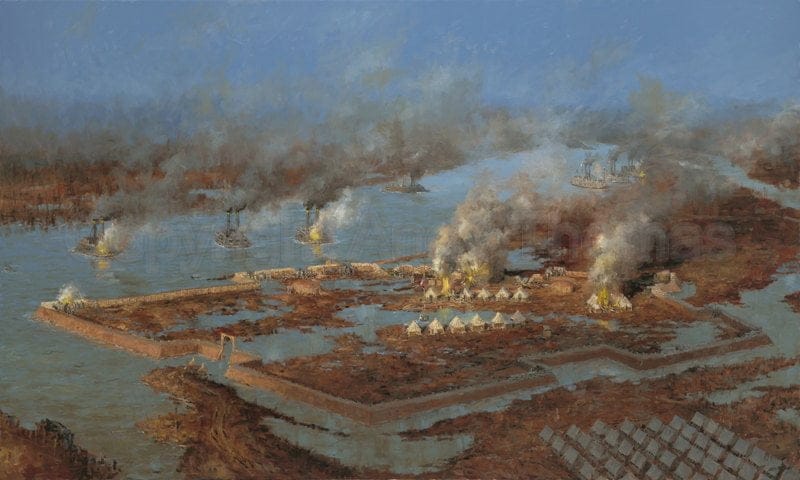
And here I'm going to read a condensed account of Benjamin Franklin Cooling's Forts Henry and Donelson: The Key to the Confederate Heartland
Foote hoisted his signal pennant to prepare for battle at about 10:20 a.m. Unknown to the navy, Grant’s soldiers were still in camp, and confusion slowed their departure to join the attack. Thirty minutes later, Foote moved upriver, his gun crews standing silently at the ready beside their cannon....The ironclads were forward, with their wooden companions located to the right rear. Fort Henry lay almost before them at eye-level due to the floodwaters. This was fortunate, for the naval cannon had elevation limitations and [that] would mean that Foote could employ point-blank fire against the fort. Still, Fort Henry’s eight-foot-high parapets were formidable, and the fourteen feet of earth could absorb much beating from enemy guns... The naval gunners could see the black muzzles of these cannon [and one 10-inch Columbiad, a type of short-barrelled super heavy cannon, hurling a 128-pound shot] peeking through embrasures formed from the sand-filled cotton sacks.
Foote’s watch showed 12:30 p.m. He had no idea where Grant’s men were; nor did he care. He would take the fort alone. Turning to flagship commander Roger N. Stembel, he gave the order to fire. Well within range of the naval guns, the opening shots were fired at 1,700 yards and fell short... Undaunted by such marginal gunnery, Foote later told his wife: “we were in sight of the fort for 2 miles. I opened the fire with rifle guns and soon they were returned by the fort. I ran up rapidly to the distance of 700 yards. It was a fearful struggle.” And so it was, as the gunboats closed rapidly, firing only their bow guns. The Confederates replied,...[with each gun captain concentrating] upon one particular vessel ... [Foote's] Flagship Cincinnati took numerous hits, and Foote explained subsequently: “We were struck with rifle and heavy shot and shell 30 times. I had the breath, for several seconds, knocked out of me, as a shot struck opposite my chest, in the ironclad pilothouse on deck.”
The accuracy of both sides improved as the gunboats moved closer to the fort... The action was “hot, rapid, and accurate as one could wish” for the first hour, with the advantage inclining toward the Confederates. In fact, Porter’s single-stack Essex received a stunning hit from the Columbiad, causing the Rebels to think they had struck a mortal blow to enemy hopes.
Porter’s young aide, Acting Master’s Mate Samuel B. Brittan, Jr., had died only a short time before as a cannonball took off his head... Then came the Columbiad shot that exploded a boiler, scalding Porter and many of his crew. James Coffey was on his knees passing a shell from an ammunition chest to a loader when the steam caught him squarely in the face, and he died in that position. Master Laning declared subsequently that the carnage below deck was “almost indescribable.” The gunboat drifted downriver and out of the fight, having fired seventy-two shots but carrying with it 10 dead, 23 wounded, and 5 missing from the one Columbiad shot alone. According to Taylor, with the Essex out of the battle line, the Yankee flotilla hesitated, halted, and seemed about to retire when a succession of catastrophes happened in the fort that restored the confidence and advance of the flotilla.
The accurate Rebel fire broke and shattered the ironclad plating “as if it had been putty, and often passed completely through the [wooden] casemates.” Foote held grimly to his task, feeling “it must be victory or death.” Just then the 24-pounder rifle in Fort Henry burst, killing or disabling the whole crew. Shortly thereafter, the Columbiad was inadvertently spiked when a priming wire jammed and bent during loading. Several of the 32-pounders were knocked out, and Confederate hopes plummeted. ...point-blank naval fire raked the parapets and spread death and destruction, Tilghman’s garrison melted from their stations in fear. By 1:30 p.m., the Kentuckian faced a moment of truth. Dismembered bodies lay beside shattered guns, fires had kindled combustibles in the fort, and demoralized officers and men milled about. Tilghman hesitated to strike his colors; he threw off his coat and jumped to serve one of the remaining cannon himself, exclaiming that he would not give up the fort.
[Inside of Fort Henry, the Confederate commanders debated whether there was any point in fighting on. Finally,] Unsure of the position of Grant’s land force, [the Confederate commander] reluctantly affixed a small white cloth to a stick and mounted the parapet. The dense battle smoke hid this flag, however, and the conflict continued for another five minutes...
Foote thought the white flag a ruse at first. Finally ordering the gunboats to cease fire, he awaited developments. Once the Confederate flag had been lowered, pandemonium broke out in the flotilla... as “a cheer ran up from this ship, a yell in fact, and I had to run among the men and knock them on the head to restore order.”
Eventually Foote made his way to Fort Henry and formally accepted the fort's surrender.
Foote made his report to Halleck, Grant, and other Union leaders within the hour, describing how “after a severe and rapid fire of an hour and fifteen minutes, the fort...surrendered."
This was the first American war that featured the telegraph, and all across the North the news spread at the spreed of... well of the telegraph. The victory electrified the Northern public. Fort Henry had fallen in just over an hour to Foote's gunboats alone. The limitations of these early ironclads were not picked up by the press and if you were to read the newspaper accounts the ironclads were unstoppable and could quickly reduce Fort Donelson as well. Grant himself was confident, telegraphing his superiors:
"I shall take and destroy Fort Donaldson [sic] on the 8th and return to Fort Henry."
This optimism would soon prove misplaced. Fort Donelson was a much tougher nut to crack.

After the rapid fall of Fort Henry, Grant was eager to capitalize on the momentum and move quickly against Fort Donelson. But he faced some significant obstacles. The weather had turned bitterly cold, with snow and sleet. The roads were a muddy, slushy quagmire, and Grant's extremely cautious commanding general from afar, General Halleck, wanted Grant to wait for reinforcements and entrench his position at Fort Henry.
Grant decided to advance anyway. On February 12th, his army set out on the 12-mile march to Fort Donelson. The mood among the troops was upbeat, even festive.
Grant's confidence was bolstered by the fact that he now had about 15,000 men, while intelligence suggested there were only about 6,000 Confederates at Fort Donelson. In reality, the defenders numbered closer to 17,000 by the time the battle began.
As Grant's army approached Fort Donelson on February 13th, they got their first look at the formidable defenses. Unlike Fort Henry, Donelson sat atop a 100-foot bluff overlooking the Cumberland River. Powerful water batteries lined the river below. A series of earthwork trenches and artillery positions stretched for two miles around the landward side.

Initial skirmishing drove in the Confederate pickets, and by nightfall Grant had invested the southern and western sides of the fort. But he lacked sufficient forces to completely encircle it. The eastern side remained open.
February 14th saw the opening of the naval attack on Fort Donelson, as Admiral Foote's gunboats steamed up the Cumberland. After the easy victory at Fort Henry, expectations were high not only on the Union sides but also with the Confederate defenders who knew this second defensive position was much stronger.
That night was bitterly cold, with temperatures dropping near zero. Many of Grant's men suffered terribly, having discarded their winter gear on the way south, believing that the Army in it's typical wastefulness had given them heavy, useless winter gear that they would not need in the sunny south.
The fort's garrison, initially under the command of Brigadier General Bushrod Johnson, was soon reinforced and taken over by the more senior Brigadier General Gideon Pillow on February 9th.
Pillow found the troops' morale low following the fall of nearby Fort Henry. He immediately set about improving spirits and defenses. In a speech to Captain Saint Claire Morgan's Irish company of the 10th Tennessee, Pillow declared: "You are Irishmen and I know you will prove true to your adopted South. I come here to drive the Hessians from this neck of land between the rivers, and I will never Surrender!"
You can hear there how he’s harkening back to the Revolutionary War, comparing the Confederacy to the American Revolutionaries and the Union Army to the hated Hessian mercenaries.
Grant's forces arrived before the fort on February 12th, with McClernand's division taking position opposite the Confederate right. Confederate General Pillow telegraphed frantically: "We shall have a battle in the morning, I think certainly, and an attack by gun-boats." He added, "I have done all that it was possible to do, and think I will drive back the enemy."
On February 14th, Flag Officer Foote's gunboat flotilla arrived and launched a determined assault on the fort. Unlike at Fort Henry, the Confederate gunners were well-prepared and put up a fierce resistance.
The Union gunboats took heavy damage. The flagship USS St. Louis was hit 59 times, including one Confederate shell struck near where Foote was standing, knocking him off his feet and somewhat ironically severing part of his foot. Nonetheless, Union gunboats pressed forward, but they were being badly mauled. Armor plates were shattered, gun crews cut down.
After about 90 minutes, Foote was forced to withdraw his battered fleet downriver. The vaunted ironclads had been repulsed, dealing a severe blow to Union morale.
That next night was also night was bitterly cold, with temperatures dropping to 10°F (-12°C). Soldiers on both sides suffered from exposure, with some freezing to death. The Confederates, despite their success against the gunboats, were in a precarious position. They were now fully surrounded by Grant's larger army and running low on supplies and despite a battering the Union fleet, there was no Southern fleet to challenge the blockade by the Union fleet on either side of the fort.
That night, the southern generals held a council of war to determine their next move. The overall commander, General John Floyd, believed their position was untenable and wanted to try to break out. General Pillow agreed. But General Simon Bolivar Buckner argued it was too late to escape and they should surrender to spare further bloodshed.
In the end, they reached a fateful compromise - they would attack to open an escape route, then withdraw the army. The assault would target the Union right flank at first light.
Dawn on February 15th saw the Confederates launch a powerful attack that caught Grant's forces completely by surprise. Grant himself was absent, having left to consult with the wounded Foote downriver.
The Union right crumbled under the Confederate onslaught. Soon an entire division was in retreat. By noon, the Confederates had opened a corridor to their rear and the road to Nashville lay open. Victory seemed within their grasp.
But then, incredibly, the Confederate attack ground to a halt. There are competing explanations for this. Some blame General Pillow for losing his nerve. Others say the Confederate troops were exhausted and disorganized after their initial success. Whatever the reason, the southerners pulled back to their original positions rather than exploiting their breakthrough.
When Grant returned to the battlefield and saw the situation, he realized he had to act fast to salvage the situation. He ordered General C.F. Smith to assault the Confederate left flank. Meanwhile, he told his battered units on the right: "Fill your cartridge-boxes, quick, and get into line; the enemy is trying to escape and he must not be permitted to do so."
Smith's attack was one of the most dramatic moments of the battle. The 60-year-old general led the charge himself, waving his cap on the end of his sword. Private William T. Shepherd of the 2nd Iowa described the scene:
"It was a fearful struggle. Right gallantly was the duty performed."
Smith's men stormed up the steep hillside and captured a section of the Confederate trenches.
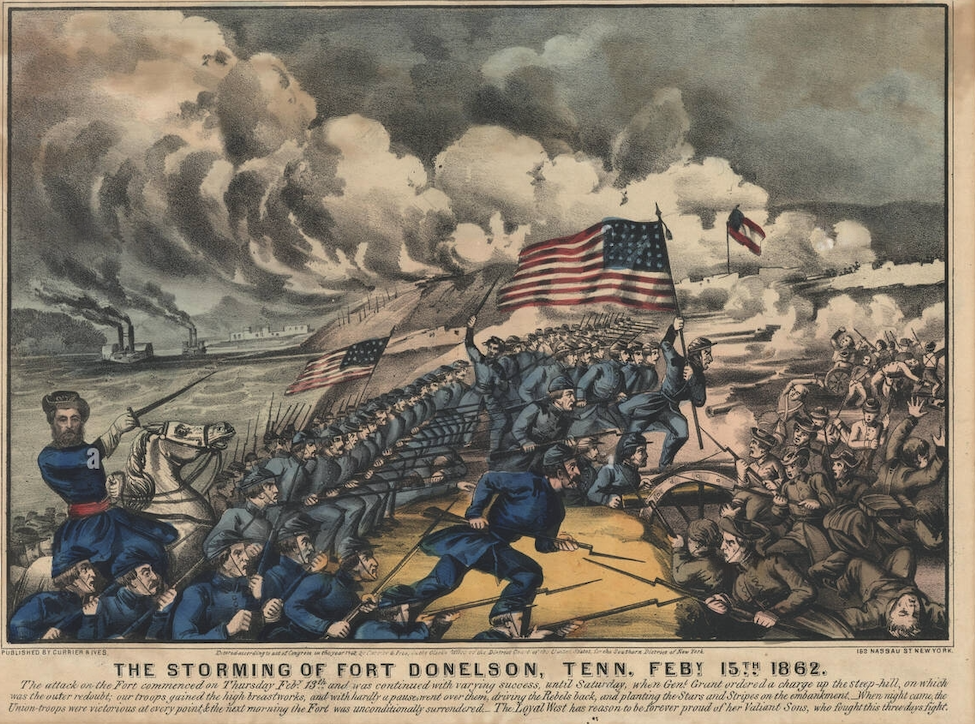
That night, the Confederate leaders held another council of war. Their attack had failed to break the siege. Smith now threatened their flank, and Grant was rushing in reinforcements. Floyd and Pillow decided to try to escape individually, leaving Buckner to surrender the army.
In the pre-dawn hours of February 16th, Floyd and Pillow slipped away on a steamboat with a small portion of the troops. Cavalry commander Nathan Bedford Forrest led his men out through a swamp. But the bulk of the Confederate army remained trapped.
That morning, Buckner sent a note to Grant requesting terms of surrender. Grant's reply became famous:
"No terms except an unconditional and immediate surrender can be accepted."
Buckner, who knew Grant from before the war, responded:
"The distribution of the forces under my command incident to an unexpected change of commanders and the overwhelming force under your command compel me, notwithstanding the brilliant success of the Confederate arms yesterday, to accept the ungenerous and unchivalrous terms which you propose."
And with that, Fort Donelson fell to Union forces. It was a stunning victory. Grant captured over 12,000 Confederate prisoners, 20,000 rifles, and 48 artillery pieces. The entire Confederate defensive line in Kentucky and Tennessee collapsed. Within days, Nashville became the first Confederate state capital to fall.
The Union victory electrified the North. Grant became an overnight sensation, nicknamed "Unconditional Surrender" Grant. His telegraph to Halleck became famous:
"We have taken Fort Donelson and from 12,000 to 15,000 prisoners, including Generals Buckner and Bushrod Johnson; also about 20,000 stand of arms, 48 pieces of artillery, 17 heavy guns, from 2,000 to 4,000 horses, and large quantities of commissary stores."
The campaign had major strategic implications. It broke open the Confederate defensive line, allowing Union forces to drive deep into Tennessee. Control of the Tennessee and Cumberland rivers gave the North invaluable avenues of invasion into the heartland of the Confederacy.
Perhaps as importantly, the twin victories at Fort Henry and Donelson provided a badly needed morale boost for the Union cause. After months of frustration and defeat, here was a decisive victory. The North had found its fighting general in Grant.
In the months that followed, Grant pressed his advantage, driving deeper into Tennessee. The next major clash would come at Shiloh in April which I’m not going to going as part of the River War, but it was the Fort Henry-Donelson campaign that truly broke open the Western theater and put the Confederacy on the defensive.

Looking back, we can see this as a pivotal moment in the war. The Union's advantages in manpower and resources began to tell. Grant emerged as the kind of aggressive, determined commander the North needed to take advantage of these strengths, and the Confederacy's defensive strategy in the West was shattered.
But at the time, the ultimate outcome remained very much in doubt. The Confederates still had large armies in the field, there was a chance that the major European powers could still intervene against the Union, and it remained to be seen if the Union had the political will to throw the bodies and money at the South necessary to compel total defeat.
What stands out to me is how this campaign showcases both the role of individual leadership and larger strategic factors in shaping military outcomes. Grant's determination and aggressiveness made a crucial difference. But so did the North's ability to concentrate superior forces and resources at the decisive point.
The campaign also highlights the importance of joint army-navy operations in the Western theater. The ironclad gunboats were a revolutionary new weapon that opened up the river systems of the interior to invasion, but by themselves they were not a war-winning weapon. Foote had wanted to wait a week for the mortar boats designed for attacking forts in the finishing stages of being built before attacking Fort Donelson instead of the ironclads better designed for dominating the river against Confederate ships. After the lessons of Fort Donelson, this lesson would be fairly well applied throughout the rest of the River War. Mortar boats combined with the Union's superiority in conventional naval forces, this gave the North a tremendous strategic advantage that it would exploit throughout the war.
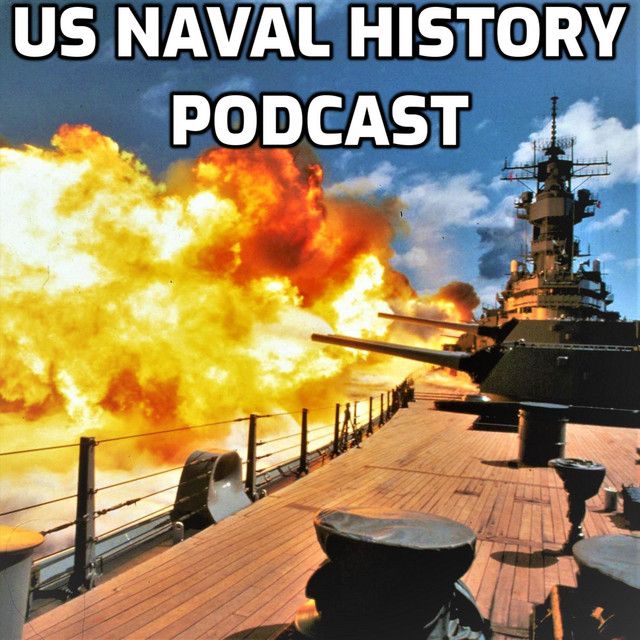
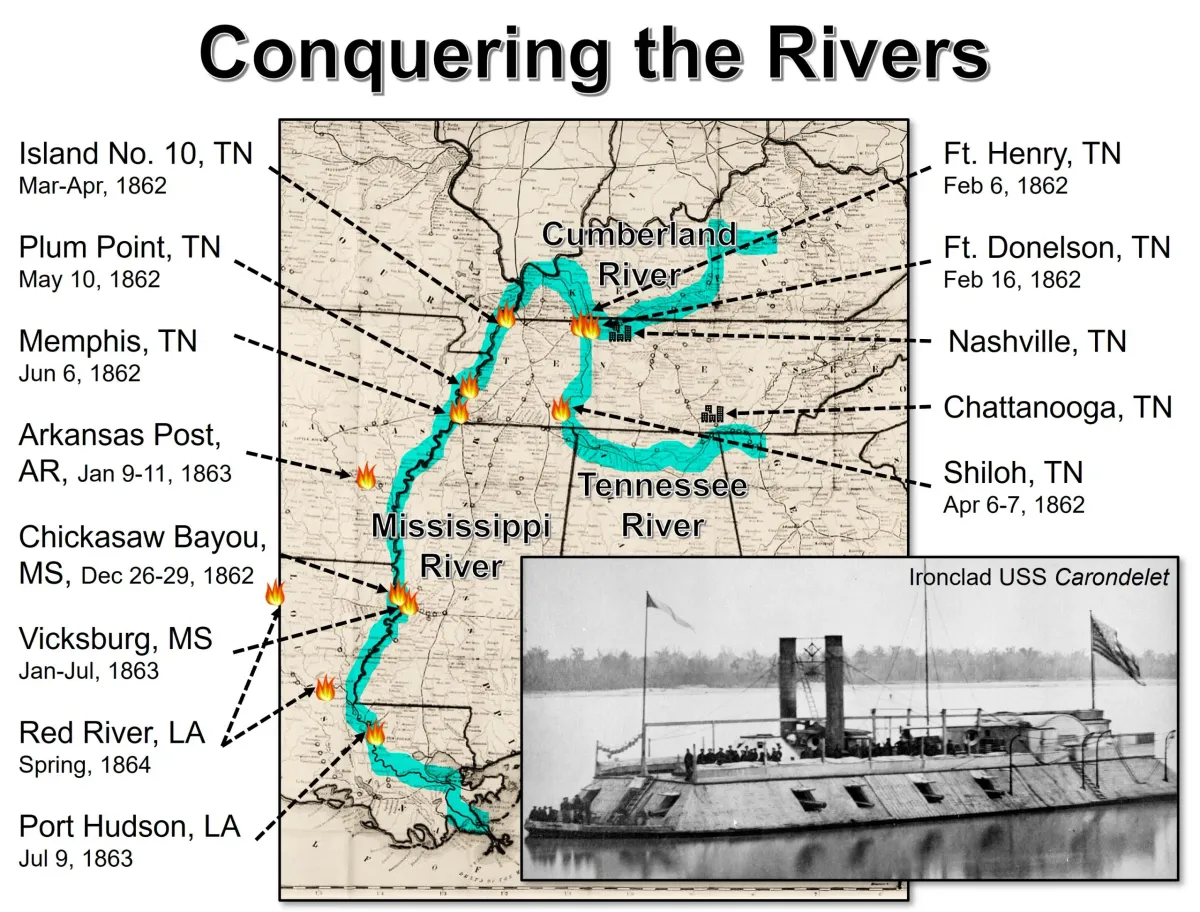
Member discussion: